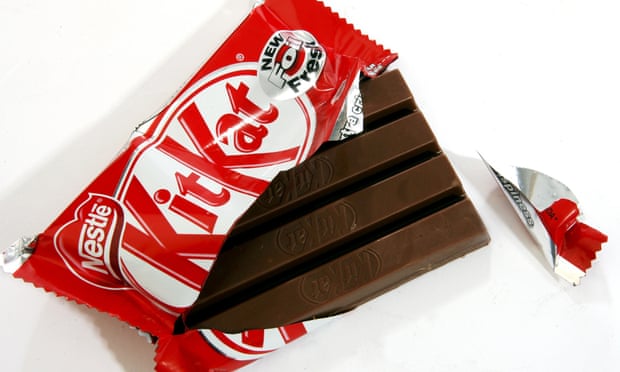(影像來源:雀巢官網)
(影像取自:http://www.theguardian.com/)
以上是雀巢公司(Nestlé Co.)巧克力產品KitKat,打開後,就是四條淋上巧克力醬的餅乾的內容,雀巢就用這個印象申請商標,本次爭議在英國商標。
根據來源文章表示,雀巢這個產品始自1935年,到了2010年才決定將此「four-finger」外觀提出商標申請,最初成功登錄,不過,Cadbury對此提出異議,一路從高等法院到歐盟司法院(CJEU),最後被駁回。(本次異議對象為英國商標案)
雀巢答辯此案時,還作了市場調查,將立體形式的four-finger圖案給一般民眾看,多數人可以認出這是雀巢的KitKat,這顯然滿足商標的識別性的要件。
然而,這個市調並不滿足商標的定義,理由是雖然調查證明這個four-finger形狀連結到產品KitKat,但卻不保證形狀單獨的商標可以辨識為雀巢的產品。歐盟司法院也提出疑問,是否當沒有其他商標(如商標"KitKat")使用時,此four-finger形狀仍可以單獨用來識別出雀巢產品?
這顯然是涉及,當此雀巢four-finger形狀作為商標申請時,過於簡單的形狀是否可以單獨成為識別其產品的商標?也就是針對雀巢將此four-finger形狀視為辨識此巧克力KitKat產品的主張,法院於是要確認:是否這four-finger形狀單獨已經足夠成為雀巢此產品的商標,而不用其他商標一起使用?
判決書分析此商標申請案的特點:長條厚片、四周有溝槽、分割出幾個手指finger。
the basic rectangular slab shape;
the presence, position and depth of the grooves running along the length of the bar, and
the number of grooves, which, together with the width of the bar, determine the number of ‘fingers’
根據1994年商標法,CJEU駁回商標申請登記,理由如以下幾點不得取得商標的規定:商標形狀來自產品本身(本次爭議商標的形狀顯然是來自巧克力本身)、產品形狀為達到技術結果的必須條件(本次爭議商標的形狀為掰開巧克力的技術手段)、商標形狀提供商標實質價值。
TMA 3(2):
(2)A sign shall not be registered as a trade mark if it consists exclusively of—
(a)the shape which results from the nature of the goods themselves,
(b)the shape of goods which is necessary to obtain a technical result, or
(c)the shape which gives substantial value to the goods.
當這個商標形狀涉及產品本身,也就是巧克力棒,還有涉及生產時必要的功能,如溝槽有技術目的,就無法取得商標權。
以上資訊提供想要申請商標(歐盟商標)的人參考!
my two cents:
雖多數人可以用雀巢這個商標申請案辨識出這是雀巢產品,似乎具有識別性,但是這也與商標取得愈來愈困難有關,商標本身形狀、文字的意義不能直接聯想到某個產品、也不能將達成某功能所產生的必要特徵作為商標,甚至商標文字本身都不能有描述商品的內容等。
補充,本次系爭商標案在英國(United Kingdom),不過可以從OHIM可以找到以下登記商標,不只四指,還有兩指與三指。
附錄:
TMA 3規定不可商標的限制:
3 Absolute grounds for refusal of registration.
(1)The following shall not be registered—
(a)signs which do not satisfy the requirements of section 1(1),
(b)trade marks which are devoid of any distinctive character,
(c)trade marks which consist exclusively of signs or indications which may serve, in trade, to designate the kind, quality, quantity, intended purpose, value, geographical origin, the time of production of goods or of rendering of services, or other characteristics of goods or services,
(d)trade marks which consist exclusively of signs or indications which have become customary in the current language or in thebona fide and established practices of the trade:Provided that, a trade mark shall not be refused registration by virtue of paragraph (b), (c) or (d) above if, before the date of application for registration, it has in fact acquired a distinctive character as a result of the use made of it.
(2)A sign shall not be registered as a trade mark if it consists exclusively of—
(a)the shape which results from the nature of the goods themselves,
(b)the shape of goods which is necessary to obtain a technical result, or
(c)the shape which gives substantial value to the goods.
(3)A trade mark shall not be registered if it is—
(a)contrary to public policy or to accepted principles of morality, or
(b)of such a nature as to deceive the public (for instance as to the nature, quality or geographical origin of the goods or service).
(4)A trade mark shall not be registered if or to the extent that its use is prohibited in the United Kingdom by any enactment or rule of law or by any provision of Community law.
(5)A trade mark shall not be registered in the cases specified, or referred to, in section 4 (specially protected emblems).
(6)A trade mark shall not be registered if or to the extent that the application is made in bad faith.
歐盟司法院(Court of Justice of the European Union (CJEU))判決書:
http://curia.europa.eu/juris/document/document.jsf?text=&docid=167821&pageIndex=0&doclang=EN&mode=lst&dir=&occ=first&part=1&cid=5377
參考文章:
http://www.ipwatchdog.com/2015/09/19/european-court-denies-nestle-four-fingered-kitkat-trademark-after-cadbury-objection/id=61694/
http://www.theguardian.com/business/2015/jun/11/nestle-kitkat-trademark-eu-law-shape
Ron





沒有留言:
張貼留言